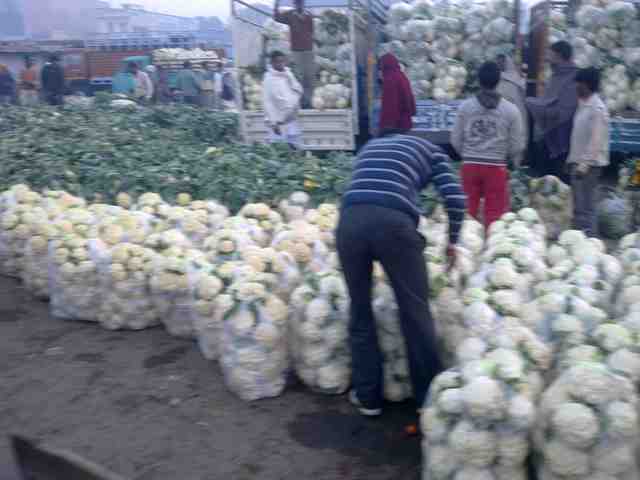We all know that buying whole sale is cheap and retail is costly. It is not just the “buying in bulk” phenomenon that makes wholesale cheaper.
I am going to use the example of vegetables in Gurgaon during winter to explain the value chain and the price differences. The photo below was taken in January this month at the Gurgaon wholesale vegetable market.
Each of the plastic bags in the photo is 20 kg+. On the day this photo was taken, three of these bags were being sold in wholesale for Rs 100. That makes the wholesale price about Rs 1.5 per kg.
Right across the road, there is, what I call a mid-tail area. Basically guys who buy from the wholesale area and sell in smaller lots of 5 kg – What they call a Dhadi. Many of the push cart vendors who sell in Gurgaon buy from these mid-tail guys. On the day of the photograph, a dhadi of cauliflower was available at Rs 20.
On the periphery of the market, you have the retailers on their push carts. You can but as little as one cauliflower from them, and the going price was Rs. 6 (special price of the day) to Rs 10 per kg!
Similarly, Corriander leaf (Dhania) was Rs 10 for 1.5 kg in wholesale and as much as Rs 40 in retail in the city and so on.
What is it that takes the retail price to as much as six to seven times the wholesale price? Is it just the convenience of breaking bulk?
There are atleast five items that contribute to the high cost of products in retail.
1. These vendors have a huge cost of operating capital. What you have heard of about micro-finance institutions pale into insignificance compared to their cost of capital. They borrow money in the morning to buy goods. And they have to pay back this borrowed capital along with interest in the evening. Many many years back, the rate of interest was 11% (You borrow Rs 90 in the morning and return back Rs 100 in the evening). Does that sound small? In reality it works out to (10 x 365 x 100 /90) a whopping 4056 % of annual interest!
2. Then there is the cost of unsolds. Vegetables are perishables, and with no storage facilities available to the bottom of the sales pyramid, anything unsold is as good as wasted. The cost of this wastage is obviously loaded on to the buyer.
3. Third in the list are the various rentals he has to pay. His push cart is rented from someone who rents out dozens. The space he stands on comes at a rent (legal or otherwise). The common balance or electronic scale he uses is also in all probability rented.
4. The fourth element is obviously his own profit.
5. There may also be a fifth cost – of a junior or Chotu who is employed once his business crosses a certain scale.
As can be seen, the higher prices in retail are not necessarily from value additions, but also from value leakages and environmental constraints. If we can reduce these, can we possibly reduce the gap between wholesale and retail prices?
(NOTE: This is just an indicative example, and the exact details and ratios could vary widely depending on the product, the market and the season.)

How about thinking on the lines of group buying, which is wholesale price for retail purchase. Groupon, LivingSocial are great examples.
I know this concept could be tough to apply on fresh vegetables, but should work for other items.
Yes,group buying is one of the answers that has evolved to remove the middle man in the chain. Costco, i would guess is half way there, but is difficult to replicate without scale.
Come to think of it, scale is the key issue
BTW, thanks for the comment which came almost as soon as I had the post up 🙂